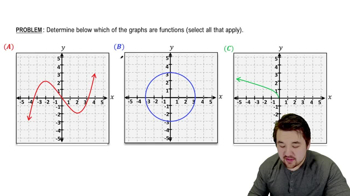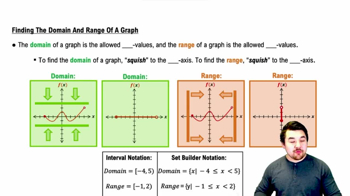Table of contents
- 0. Functions7h 52m
- Introduction to Functions16m
- Piecewise Functions10m
- Properties of Functions9m
- Common Functions1h 8m
- Transformations5m
- Combining Functions27m
- Exponent rules32m
- Exponential Functions28m
- Logarithmic Functions24m
- Properties of Logarithms34m
- Exponential & Logarithmic Equations35m
- Introduction to Trigonometric Functions38m
- Graphs of Trigonometric Functions44m
- Trigonometric Identities47m
- Inverse Trigonometric Functions48m
- 1. Limits and Continuity2h 2m
- 2. Intro to Derivatives1h 33m
- 3. Techniques of Differentiation3h 18m
- 4. Applications of Derivatives2h 38m
- 5. Graphical Applications of Derivatives6h 2m
- 6. Derivatives of Inverse, Exponential, & Logarithmic Functions2h 37m
- 7. Antiderivatives & Indefinite Integrals1h 26m
0. Functions
Introduction to Functions
Problem 112a
Textbook Question
Daylight function for 40 °N Verify that the function D(t)=2.8sin(3652π(t−81))+12 has the following properties, where t is measured in days and D is the number of hours between sunrise and sunset. It has a period of 365 days.
 Verified step by step guidance
Verified step by step guidance1
Identify the general form of a sinusoidal function, which is typically given by A \sin(B(t - C)) + D, where A is the amplitude, B affects the period, C is the phase shift, and D is the vertical shift.
In the given function D(t) = 2.8 \sin\left(\frac{2\pi}{365}(t-81)\right) + 12, compare it to the general form to identify the values of A, B, C, and D. Here, A = 2.8, B = \frac{2\pi}{365}, C = 81, and D = 12.
The period of a sinusoidal function is determined by the coefficient B in front of t. The formula for the period is \frac{2\pi}{B}.
Substitute B = \frac{2\pi}{365} into the period formula: \text{Period} = \frac{2\pi}{\frac{2\pi}{365}}.
Simplify the expression for the period to verify that it equals 365 days, confirming that the function has the desired period.
Recommended similar problem, with video answer:
 Verified Solution
Verified SolutionThis video solution was recommended by our tutors as helpful for the problem above
Was this helpful?

 1:36m
1:36mWatch next
Master Introduction to Calculus Channel with a bite sized video explanation from Callie
Start learning





